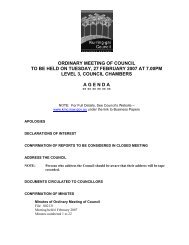Pymble Business Park - Ku-ring-gai Council
Pymble Business Park - Ku-ring-gai Council
Pymble Business Park - Ku-ring-gai Council
Create successful ePaper yourself
Turn your PDF publications into a flip-book with our unique Google optimized e-Paper software.
8.4 MATERIALS, FINISHES AND COLOURS<br />
Objectives<br />
1 To ensure buildings have<br />
a low environmental<br />
impact.<br />
2 To limit pollution and<br />
protect public health and<br />
comfort.<br />
3 To design buildings that<br />
provide optimum thermal<br />
conditions wherever<br />
possible.<br />
4 To reduce natural,<br />
particularly nonrenewable,<br />
resource<br />
consumption.<br />
5 To ensure material<br />
selection has been equally<br />
driven by environmental<br />
sustainability,<br />
safety, commercial<br />
competitiveness and<br />
quality.<br />
6 To promote use of<br />
materials and finishes that<br />
contribute to the design of<br />
innovative buildings.<br />
Controls<br />
Sustainability of Building Materials<br />
1 Developments must use building materials which:<br />
i) are recycled or recyclable with low embodied energy;<br />
ii) come from renewable sources or those that are sustainable and<br />
generate a lower environmental cost;<br />
iii) have acceptable life cycle costs and durability;<br />
iv) involve environmentally acceptable production methods; and<br />
v) use building materials which are recycled or recyclable, come<br />
from renewable sources or involve environmentally acceptable<br />
production methods.<br />
2 Rainforest timbers and timbers from old growth forests must not be<br />
specified for the construction or finishing of the development.<br />
3 Medium Density Fibreboard (MDF) and particleboard must not be<br />
specified as a construction material for the development.<br />
4 The use of alternatives to PVC piping is highly encouraged including<br />
Colorbond (above ground only), and HDPE where appropriate.<br />
5 Avoid the use of construction materials and chemicals with toxic<br />
components to facilitate recycling and reduce pollution.<br />
6 Structures must be designed with physical, rather than chemical,<br />
termite measures. This can be achieved by:<br />
i) appropriate materials and construction design;<br />
ii) physical barriers;<br />
iii) suspended floor systems.<br />
7 Low Volatile Organic Compounds (VOC) must be used throughout<br />
the building interior (carpets, paints, adhesives, sealants and all<br />
other finishes), and low emission building materials are to be used<br />
across the site.<br />
8 Avoid the use of ozone depleting products and materials, or products<br />
and materials manufactured using ozone depleting substances.<br />
9 Avoid materials likely to contribute to poor internal air quality, such as<br />
those generating formaldehyde, or those that may create a breathing<br />
hazard in the event of fire, such as polyurethane<br />
p 98<br />
Figure 8.4-1<br />
Recycled timber wall as a<br />
feature in the entry lobby.<br />
Draft <strong>Ku</strong>-<strong>ring</strong>-<strong>gai</strong> <strong>Pymble</strong> <strong>Business</strong> <strong>Park</strong> Development Control Plan 2012<br />
10 The requirements below apply only to non-residential development:<br />
i) Use heavy weight building materials such as concrete as thermal<br />
mass on roofs and/or walls. Where lighter weight materials are<br />
used they are to be well insulated.<br />
ii) Encourage the use of photovoltaic cells which can be mounted<br />
as panels, or used as an integrated building cladding or sun<br />
shading.<br />
iii) Light coloured internal finishes shall be utilised to improve<br />
internal reflections and minimise lighting use.

















